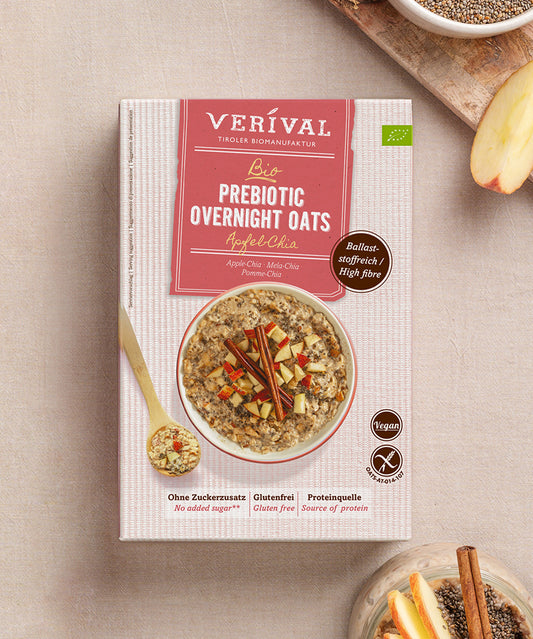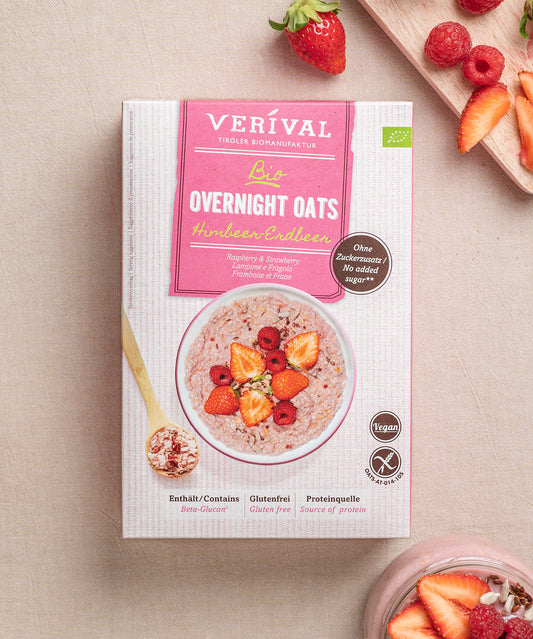Interval fasting, for example according to the 20:4 rhythm, is now part of the basic repertoire of healthy nutrition for many people. It is often said to have positive effects on health and to be an effective way to lose weight. However, so-called intermittent fasting or interval fasting, is not a type of therapeutic fasting or a diet for quick weight loss.
Instead, it is a form of nutrition in which daily periods of fasting are integrated into your daily diet. The pounds may not drop as quickly as they would on a crash diet, but it can help to prevent the dreaded yo-yo effect, allowing you to benefit from the weight loss in the long term. In this article, we will look at the effects of intermittent fasting in a 20:4 rhythm on your health and how you can integrate this form of nutrition into your daily routine.
Intermittent fasting – find out more now!
Fasting in a 20:4 rhythm
If you have already done a little research on intermittent fasting, you will have noticed one thing: there are almost countless variations of it. Some fans of intermittent fasting only eat every other day, others fast daily for a certain period of time. Intermittent fasting in a 20/4 rhythm is one of the latter.
During this method, you eat for a period of four hours, with the remaining 20 hours constituting the fasting interval, during which you consume no calories. Four hours is a very short time in which to eat, so sufficient planning is recommended to ensure you consume all the essential nutrients.
The big advantage of this somewhat more extreme form of intermittent fasting is that the eating phase is so short that your calorie intake will be significantly reduced. This, in turn, can help you to reduce body fat by putting you in a calorie deficit – in other words, by consuming fewer calories than your body would need in principle to maintain your body mass. You can calculate your needs with a calorie calculator.
In addition, the 20-hour fasting period ensures that your insulin levels remain stable for most of the day. This helps to avoid an unnecessary increase in body fat, which can result from high fluctuations in blood sugar levels. In addition, a natural process in the body is activated more strongly, in which the cells regenerate – this is called autophagy in technical jargon.
What 20 hours of fasting a day can do for you
As you can see, 20:4 intermittent fasting can have some advantages. As mentioned earlier, the reduced energy intake plays a significant role in this. The calorie deficit sets some body processes in motion that are beneficial to your health, provided that you supply your body with sufficient micronutrients despite the reduced calorie intake 1 .
The biggest effect of calorie restriction is on weight loss. On the one hand, it can effectively prevent obesity and associated health conditions. On the other hand, intermittent fasting can help you to reduce your body fat percentage and thus alleviate existing problems 2,3.
Incidentally, the calorie deficit is not only due to the limited eating time; other factors also play a role. For example, cravings are avoided due to the reduced fluctuations in blood sugar levels. According to some studies, general appetite also seems to be curbed 4.
But other effects of intermittent fasting also have advantages. The 20-hour fast period boosts fat burning. During the calorie-free period, glucose stores are gradually used up until a new process is set in motion after about 12 hours: the body's fat reserves are now converted into ketones 3. And this is precisely the physiological basis for how losing weight with intermittent fasting can work.
Last but not least, the long period of fasting results in a kind of detoxification of the body. The cells can regenerate better because the body's own recycling system, autophagy, is accelerated – this is how the body is “detoxified”, so to speak 5.
Read all about intermittent fasting!
Who should refrain from intermittent fasting in a 20/4 rhythm
As many advantages as intermittent fasting has to offer, there are also some limitations. Many of these only become apparent when we take a step back from the details and look at it from an everyday perspective. It becomes clear that when it comes to intermittent fasting, especially when it comes to a more extreme form such as the 20/4 rhythm, some hurdles can arise.
While people who live alone and have a 9-to-5 job can easily adjust their rhythm as they please, it's not that easy for others. Sometimes it's the job that doesn't allow it, for others it's social aspects that get in the way. For many families, for example, dinner is an important part of (food) culture. So here it is important to consider whether everyday family life is compatible with this form of nutrition at all.
People who have been struggling with physical or mental illnesses all their lives or have only recently begun to do so should discuss their planned dietary changes with their doctor or dietician to avoid complications. Eating disorders, hypoglycemia or even weakness, especially in older people, can be a risk due to the longer period of fasting.
Practical example: what a fasting day in a 20:4 rhythm might look like
Let's now take a look at what a healthy diet in a 20:4 rhythm might look like. For most people, it will probably be most convenient to schedule the four-hour window for the meal in the middle of the day. This could be from about 11 a.m. to 3 p.m.
In any case, eating too late is not recommended, as this could potentially negate the benefits for the metabolism and cardiovascular system. Based on the natural rhythm of the body, called the “circadian clock”, food intake is recommended between eight in the morning and four in the afternoon 6,7.
So a late breakfast around 11 a.m. would be optimal. If you are already at the office at that time, you could benefit from meal prep breakfast. Overnight oats, for example, are suitable for this, which you can prepare the day before and easily take with you to work.
At 1 p.m., you could now have your usual lunch; two hours later, there would now be time for your third and final meal of the day. It's best to eat something that will keep you energized for a long time. Suitable options include whole grains or oats. A delicious porridge with healthy nuts as a topping will provide you with complex carbohydrates and healthy fatty acids that will keep you feeling full for a long time.
If you do get hungry in between, you can always have some water or unsweetened tea. Both are calorie-free and are therefore allowed during the fasting period. When it comes to coffee, however, there are conflicting approaches. While for some, even black coffee is off limits, some experts even consider caffeine consumption to be beneficial.
Whether you consume black coffee (without milk and sugar) is therefore up to you. In any case, you should not exceed the recommended maximum of 200 milligrams of caffeine per day. In practice, this means no more than three cups of coffee a day 8.
Healthy organic breakfast from Verival – discover it now
What are some of the other common methods of intermittent fasting?
Besides the 20:4 method, there are a number of other variations of intermittent fasting. In most cases, you follow the same daily rhythm and only the daily fasting period varies. However, in some variations, you only eat every other day; or the amount of calories consumed is drastically reduced every other day.
The latter is referred to as Alternate Day Fasting. There are two basic variations of this diet 9:
- One day you eat as much as you want, and the next day you fast for 24 hours.
- One day you eat as much as you want, and the next day you consume 25% or less of your maintenance calories.
Other popular variations of intermittent fasting revolve around so-called time-restricted feeding, which includes the 20:4 rhythm. This involves maintaining an equal fasting window each day; 12 hours is the minimum. The following are the top 10 popular variations:
- In the 14:10 variant, the period of eating breaks is a minimum of 14 hours, while you can eat whatever you want for the remaining 10 hours.
- In the 16:8 method, on the other hand, you fast for a full 16 hours; the window for solid food is thus limited to 8 hours.
- The 20:4 rhythm is probably the most extreme variant, with a fasting period of 20 hours. Calories are consumed in just four hours.
In principle, it is recommended to eat the first meal of the day in the morning when fasting. You should also not eat the last meal of the day too late, ideally not after four o'clock in the afternoon . This is based on the circadian rhythm, the body's biological “internal clock”. According to this, food intake is aligned with the body's natural hormonal fluctuations, which appears to reduce the risk of obesity, diabetes and cardiovascular disease 6 .
Tips for successful intermittent fasting with the 20/4 method
Last but not least, we would like to give you a few tips for your daily nutrition. Therefore, we have compiled a list of mistakes in interval fasting that you should better avoid:
- Avoid highly processed foods (fast food, ready meals).
- Avoid empty calories (soft drinks, biscuits, crisps, etc.).
- Avoid alcohol as much as possible in the period before fasting.
- Smokers run the risk of an increased craving for nicotine during fasting – so pay close attention and avoid unnecessary compensation 8.
Now we have a few more valuable tips to help you get even more out of intermittent fasting:
- Ideally, you should do intense exercise during or shortly after your eating period. During the fasting phase, especially if it lasts a long time like in the 20:4 method, you should opt for gentler forms of exercise (yoga, stretching, gentle cardio) 11 .
- Eat a balanced, healthy diet. This means eating as many unprocessed foods as possible that are rich in vitamins and minerals. You should also eat enough long-chain carbohydrates, healthy fatty acids, and digestive fiber.
- Make sure you drink enough! This will help you to control your hunger and at the same time support your body in getting rid of “endogenous waste”, thus improving your immune system.
Read all about intermittent fasting!
Frequently asked questions about 20:4 fasting
Let's now take a closer look at some questions that come up again and again.
How much weight can you lose with 20:4?
Weight loss with intermittent fasting depends not only on the respective fasting protocol, but also on individual factors. Accordingly, the weight loss you can achieve with intermittent fasting methods such as the 20:4 rhythm varies. In general, you can expect to lose between 2.5 and 9.9 percent of your body weight. For a person weighing 85 kilograms, this would be around 2 to 8.5 kilograms. It is hardly possible to give more precise values, as the weight loss success is subject to numerous variables. The initial weight, any mental or physical illnesses, and age play a crucial role 12 .
How long can you fast with 20:4?
How long you can fast using the 20:4 method is up to you. As long as you get enough nutrients, there is no reason to stop intermittent fasting. You can therefore consider intermittent fasting as a long-term dietary change if you feel comfortable with it.
What happens when you fast for 20 hours?
The processes that fasting sets in motion are complex and wide-ranging. One of the main changes is a modification of the energy metabolism. If you don't eat anything containing energy for 20 hours, your body gradually adjusts its energy production. After the sugar circulating in the blood has been slowly broken down, your body increasingly relies on the carbohydrate stores in the liver.
After a while, the “metabolic switch” occurs, in which your body now metabolizes more fatty acids instead of carbohydrates. This usually happens after about 12 hours of fasting. This is considered the basis for the observed weight loss success of intermittent fasting 13.
Sources
- Hofer SJ, Carmona-Gutierrez D, Mueller MI, Madeo F. The ups and downs of caloric restriction and fasting: from molecular effects to clinical application. EMBO Mol Med. Published online November 15, 2021. doi: 10.15252/emmm.202114418
- Trepanowski JF, Kroeger CM, Barnosky A, et al. Effect of Alternate-Day Fasting on Weight Loss, Weight Maintenance, and Cardioprotection Among Metabolically Healthy Obese Adults. JAMA Intern Med . Published online July 1, 2017:930. doi: 10.1001/jamainternmed.2017.0936
- Vasim I, Majeed CN, DeBoer MD. Intermittent Fasting and Metabolic Health. Nutrients . Published online January 31, 2022:631. doi: 10.3390/nu14030631
- Zang BY, He LX, Xue L. Intermittent Fasting: Potential Bridge of Obesity and Diabetes to Health? Nutrients . Published online February 25, 2022:981. doi: 10.3390/nu14050981
- Jamshed H, Beyl R, Della Manna D, Yang E, Ravussin E, Peterson C. Early Time-Restricted Feeding Improves 24-Hour Glucose Levels and Affects Markers of the Circadian Clock, Aging, and Autophagy in Humans. Nutrients . Published online May 30, 2019:1234. doi: 10.3390/nu11061234
- Charlot A, Hutt F, Sabatier E, Zoll J. Beneficial Effects of Early Time-Restricted Feeding on Metabolic Diseases: Importance of Aligning Food Habits with the Circadian Clock. Nutrients . Published online April 22, 2021:1405. doi: 10.3390/nu13051405
- St-Onge MP, Ard J, Baskin ML, et al. Meal Timing and Frequency: Implications for Cardiovascular Disease Prevention: A Scientific Statement From the American Heart Association. Circulation . Published online February 28, 2017. doi: 10.1161/cir.0000000000000476
- Attinà A, Leggeri C, Paroni R, et al. Fasting: How to Guide. Nutrients . Published online May 7, 2021:1570. doi: 10.3390/nu13051570
- Harris L, Hamilton S, Azevedo LB, et al. Intermittent fasting interventions for treatment of overweight and obesity in adults. JBI Database of Systematic Reviews and Implementation Reports. Published online February 2018:507-547. doi: 10.11124/jbisrir-2016-003248
- Cioffi I, Evangelista A, Ponzo V, et al. Intermittent versus continuous energy restriction on weight loss and cardiometabolic outcomes: a systematic review and meta-analysis of randomized controlled trials. J Transl Med. Published online December 2018. doi: 10.1186/s12967-018-1748-4
- Zouhal H, Saeidi A, Salhi A, et al. <p>Exercise Training and Fasting: Current Insights</p> OAJSM . Published online January 2020:1-28. doi: 10.2147/oajsm.s224919
- Stockman MC, Thomas D, Burke J, Apovian CM. Intermittent Fasting: Is the Wait Worth the Weight? Curr Obes Rep . Published online April 26, 2018:172-185. doi: 10.1007/s13679-018-0308-9
- Anton SD, Moehl K, Donahoo WT, et al. Flipping the Metabolic Switch: Understanding and Applying the Health Benefits of Fasting. Obesity. Published online October 31, 2017:254-268. doi: 10.1002/oby.22065
Intermittent fasting, for example, after the 20:4 rhythm , is now part of the basic repertoire of a healthy diet for many. There is often talk of positive effects on health and effective weight loss. However, so-called intermittent fasting or short intermittent fasting is not about a kind of healing fast or a diet for rapid weight loss.
Instead, it is a form of nutrition in which daily fasting periods are integrated into the daily diet. The pounds do not tumble as quickly as with a crash diet, but this can prevent the dreaded yo-yo effect, which can benefit you in terms of weight loss in the long term. In this article, we take a look at the effects of intermittent fasting in a 20:4 rhythm on your health and how you can integrate the diet into your everyday life.
Fasting in rhythm 20 to 4
If you have already dealt with intermittent fasting, you will have noticed one thing: there are countless variants of it. Some fans of intermittent fasting only eat every other day, while others fast daily for a period of time. Intermittent fasting in a rhythm of 20 to 4 is one of the latter.
The meal time is limited to a period of four hours. The remaining 20 hours form the fasting interval in which no calories are consumed. Four hours is a relatively short time for your meals. Adequate planning is therefore recommended in order to consume all the important nutrients.
The significant advantage of this slightly more extreme form of intermittent fasting is that the eating phase is so short that your calorie intake will be significantly reduced . This, in turn, can help you reduce your body fat by being in a calorie deficit – that is, eating fewer calories than your body would need to maintain body mass. By the way, you can calculate your needs with a calorie calculator .
In addition, the 20-hour fast ensures that your insulin levels remain stable for most of the day . For example, an unnecessary increase in body fat, which can be caused by high fluctuations in blood sugar levels, is avoided. In addition, a natural process of the body is activated more strongly, during which the cells regenerate – this is called autophagy in technical terminology.
What can bring 20 hours of fasting a day
As you can see, 20:4 intermittent fasting can have some benefits. A significant part of this, as mentioned earlier, is the reduced energy consumption . This is because the calorie deficit triggers some body processes that are beneficial to your health; provided that you provide your body with sufficient micronutrients despite the reduced amount of calories 1 .
The calorie deficit has the greatest effect on weight loss . On the one hand , obesity and associated diseases can be effectively prevented . On the other hand, intermittent fasting can cause you to specifically reduce your body fat percentage and thus reduce existing problems 2,3 .
Incidentally, the calorie deficit is not only due to the limited eating time; other factors also play a role. For example, due to the reduced fluctuations in blood sugar levels , cravings are avoided. According to some studies, the general appetite also seems to be curbed 4 .
But other effects of intermittent fasting also have advantages. Thus, the 20-hour fasting period stimulates fat burning. Because during the time without calories, the glucose stores are gradually used up until a new process is started after about 12 hours: the body's fat reserves are now converted into ketones 3 . And that is exactly the physiological basis for how weight loss can be achieved with intermittent fasting .
Last but not least, the long fasting period leads to a kind of detoxification of the body . The cells can regenerate better by accelerating the body's own recycling system , autophagy – so the body is, in a way, "detoxified" 5 .
Who should better refrain from intermittent fasting in a 20/4 rhythm
As many advantages as intermittent fasting has to offer, there are also some limitations. Many of them only become visible when a step away from the detail towards everyday life is taken. It is clear here that some hurdles can arise with intermittent fasting , especially if it is a slightly more extreme form, such as the 20/4 rhythm.
For example, while people who live alone and have a 9-to-5 job can adjust their rhythm at will, this is not too easy for others. Sometimes the job does not allow it; for others, social aspects stand in the way. For many families, for example, dinner is an important part of (food)culture . It is therefore important to consider whether everyday family life is compatible with this diet at all.
In any case, people who have been struggling with physical or mental illness all their lives or only recently should discuss their planned dietary change with their doctor or dietician in order to avoid complications. Eating disorders, hypoglycaemia, or feeling weak, especially in older people, can result from the prolonged period of fasting.
Practical example: This is how a fasting day can look like in a 20: 4 rhythm
Now let's look at what a healthy diet in a 20:4 rhythm could look like. For most people, it will probably be most pleasant to set the four-hour window for the meal in the middle of the day. This could be from about 11 am to 3 pm.
Eating too late is not recommended in any case, as this could potentially negate the benefits on the metabolism as well as the cardiovascular system. Based on the body's natural rhythm , called the "circadian clock," eating between eight in the morning and four in the afternoon is recommended 6.7 .
Thus, a late breakfast around 11 o'clock in the morning would be optimal. Those who are already at the office at that time could benefit from meal prep breakfast . Overnight oats, for example, are suitable for this, which you can prepare the day before and easily take with you to work.

Recipe: Bircher Muesli Overnight Oats
Ingredients
- 50 g Bircher Porridge
- 120 ml (vegetable) milk or water
- Some nuts of your choice , e.g. pecans or almonds
- A little apple of your choice
Preparation
-
Place the Bircher Porridge in a mason jar.
-
Then add 120 ml of a liquid of your choice and mix the ingredients together well.
-
Place the mason jar overnight or for a minimum of 3 hours in the fridge.
-
Stir the porridge mixture well again before eating.
-
When your overnight oats are nice and creamy, they're ready.
-
Now you can refine your overnight oats with nuts of your choice, flaxseed or chia seeds, and an apple.
Tip
At 1 pm, you could have your usual lunch ; two hours later , there would still be time for your third and last meal of the day . It's best to eat something that provides you with energy for a long time. For example, whole grain cereals or oatmeal are suitable. A delicious porridge with healthy nuts as a topping will provide you with complex carbohydrates and healthy fatty acids that will keep you full for a long time.

Recipe: Porridge with oat bran
Ingredients
- 60 g oat bran
- 250 ml (vegetable) milk or water
Preparation
-
Boil (vegetable) milk or water in a saucepan and add oat bran.
-
Reduce the heat a little and simmer for a few minutes, stirring constantly, until the mixture becomes creamy.
-
Remove from the heat and let it steep for another minute.
-
Depending on the desired consistency, you can still add liquid.
Tip
If you still get hungry in between, you can always add some water or unsweetened tea . Both have no calories and are therefore also allowed during fasting. On the other hand, there are contradictory approaches to coffee. While black coffee is taboo for some, some experts even see caffeine consumption as beneficial.
Whether you consume black coffee , i.e. without milk and sugar, is up to you. In any case, you should not exceed the recommended maximum for caffeine, which is 200 milligrams per day. In practice, this means no more than three cups of coffee per day 8 .
What are other common methods for intermittent fasting?
In addition to the 20:4 method, there are a variety of other variations of intermittent fasting. In most cases, you are in a constant daily rhythm and only the daily fast varies. In some variations, however, only every other day is eaten; or the amount of calories consumed on every other day is drastically reduced.
In the latter variations, there is talk of alternate day fasting. In this diet, there are two basic variants 9 :
- One day you can eat as much as you want; the next day you fast for 24 hours
- One day you eat as much as you want; the next day you consume 25% or less of your maintenance calories

Other popular variations of intermittent fasting revolve around so-called time-restricted feeding, which also includes the 20:4 rhythm. A fasting window of the same size is maintained every day; 12 hours of fasting is the minimum. Popular variations are the following 10 :
- With the 14:10 variant , the minimum period of food breaks is 14 hours, while you can eat at your leisure for the remaining 10 hours.
- With the 16:8 method , on the other hand, the duration of fasting is a full 16 hours; the time window for solid food is thus limited to 8 hours.
- With a fasting time of 20 hours, the 20: 4 rhythm is probably the most extreme variant. The calories are consumed in just four hours.
For intermittent fasting, it is generally recommended to take the first meal of the day in the morning . You should also not eat the last meal of the day too late, ideally not after four o'clock in the afternoon . This is justified with the circadian rhythm, i.e. the biological, "internal clock" of the body. Accordingly, food intake is brought into line with the body's natural hormone fluctuations , which seems to reduce the risk of obesity, diabetes, and cardiovascular disease 6 .
Tips for successful intermittent fasting with the 20 to 4 method
Last but not least, we would like to give you some tips for your daily diet. In the following, we have therefore compiled a list of errors in intermittent fasting that you should better avoid :
- Avoid highly processed foods (fast food, ready meals).
- Avoid empty calories (soft drinks, cookies, chips, etc.).
- Avoid alcohol as much as possible in the period before fasting.
- As a smoker, there is a risk that the desire for nicotine increases during fasting – so pay closer attention and avoid unnecessary compensation 8
Now we have a few valuable tips to help you get even more out of intermittent fasting:
- You should ideally exercise intensively during or shortly after the end of the meal time. During the fasting phase, especially if it lasts a very long time, as with the 20:4 method, you should rather rely on gentler sports units (yoga, stretching, gentle endurance training) 11 .
- Maintain a balanced, healthy diet . This means using products that are as unprocessed as possible and rich in vitamins and minerals . In addition, you should consume enough long-chain carbohydrates , healthy fatty acids and digestive fiber
- Make sure you drink enough ! In this way, you can keep your hunger under control and at the same time support your body in getting rid of "endogenous waste" and thus improve your defenses.
20:4 Fasting Frequently Asked Questions
Now let's take a closer look at a few questions that keep coming up.
How much do you lose at 20:4?
The weight loss during intermittent fasting depends not only on the respective fasting protocol but also on individual factors. Accordingly, the weight loss success you can achieve with intermittent fasting methods such as the 20:4 rhythm varies. In general, you can expect a weight loss of 2.5 to 9.9 percent. For a person weighing 85 kilograms, this would be about 2 to 8.5 kilograms. It is hardly possible to give more precise values, as the customer success is subject to numerous variables. Thus, the starting weight, any mental or physical illnesses, and age play a decisive role 12 .
How long can you fast at 20:4?
How long you can fast after the 20:4 method is up to you. Because as long as you cover your nutrient needs sufficiently, there is no reason to end the intermittent fasting. You can therefore consider intermittent fasting as a long-term dietary change if you feel comfortable with it.
What happens when you fast for 20 hours?
The processes that are set in motion by fasting are versatile and complex. A significant change is, for example, a change in energy metabolism. If you do not eat anything that contains energy for 20 hours, your body gradually converts its energy production. After the sugar circulating in the blood is slowly broken down, your body increasingly relies on the carbohydrate stores in the liver.
After some time, it now comes to the "metabolic switch", in which your body now metabolizes more fatty acids instead of carbohydrates. This usually happens after about 12 hours of fasting. This is considered to be the basis of the observed customer success of intermittent fasting 13 .
References
-
1.Hofer SJ, Carmona-Gutierrez D, Mueller MI, Madeo F. The ups and downs of caloric restriction and fasting: from molecular effects to clinical application. EMBO Mol Med . Published online November 15, 2021. doi: 10.15252/emmm.202114418
-
2.Trepanowski JF, Kroeger CM, Barnosky A, et al. Effect of Alternate-Day Fasting on Weight Loss, Weight Maintenance, and Cardioprotection Among Metabolically Healthy Obese Adults. Jama Intern Med . Published online July 1, 2017:930. doi: 10.1001/jamainternmed.2017.0936
-
3.Vasim I, Majeed CN, DeBoer MD. Intermittent Fasting and Metabolic Health. Nutrients . Published online January 31, 2022:631. doi: 10.3390/nu14030631
-
4.Zang BY, He LX, Xue L. Intermittent Fasting: Potential Bridge of Obesity and Diabetes to Health? Nutrients . Published online February 25, 2022:981. doi: 10.3390/nu14050981
-
5.Jamshed H, Beyl R, Della Manna D, Yang E, Ravussin E, Peterson C. Early Time-Restricted Feeding Improves 24-Hour Glucose Levels and Affects Markers of the Circadian Clock, Aging, and Autophagy in Humans. Nutrients . Published online May 30, 2019:1234. doi: 10.3390/nu11061234
-
6.Charlot A, Hutt F, Sabatier E, Zoll J. Beneficial Effects of Early Time-Restricted Feeding on Metabolic Diseases: Importance of Aligning Food Habits with the Circadian Clock. Nutrients . Published online April 22, 2021:1405. doi: 10.3390/nu13051405
-
7.St-Onge MP, Ard J, Baskin ML, et al. Meal Timing and Frequency: Implications for Cardiovascular Disease Prevention: A Scientific Statement From the American Heart Association. Circulation . Published online February 28, 2017. doi: 10.1161/cir.0000000000000476
-
8.Attinà A, Leggeri C, Paroni R, et al. Fasting: How to Guide. Nutrients . Published online May 7, 2021:1570. doi: 10.3390/nu13051570
-
9.Harris L, Hamilton S, Azevedo LB, et al. Intermittent fasting interventions for treatment of overweight and obesity in adults. JBI Database of Systematic Reviews and Implementation Reports . Published online February 2018:507-547. doi: 10.11124/jbisrir-2016-003248
-
10.Cioffi I, Evangelista A, Ponzo V, et al. Intermittent versus continuous energy restriction on weight loss and cardiometabolic outcomes: a systematic review and meta-analysis of randomized controlled trials. J Transl Med . Published online December 2018. doi: 10.1186/s12967-018-1748-4
-
11.Zouhal H, Saeidi A, Salhi A, et al. Exercise Training and Fasting: Current Insights.
OAJSM
Published online January 2020:1-28. doi: 10.2147/oajsm.s224919 -
12.Stockman MC, Thomas D, Burke J, Apovian CM. Intermittent Fasting: Is the Wait Worth the Weight? Curr Obes Rep. Published online April 26, 2018:172-185. doi: 10.1007/s13679-018-0308-9
-
13.Anton SD, Moehl K, Donahoo WT, et al. Flipping the Metabolic Switch: Understanding and Applying the Health Benefits of Fasting. Obesity . Published online October 31, 2017:254-268. doi: 10.1002/oby.22065
























